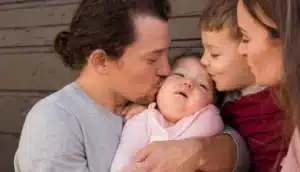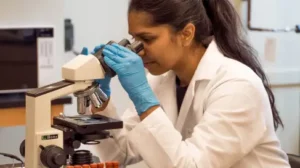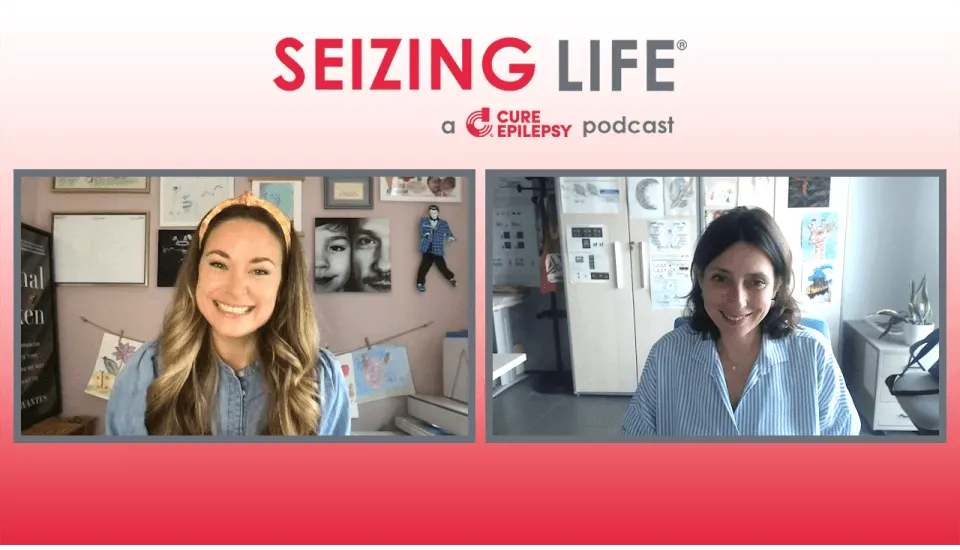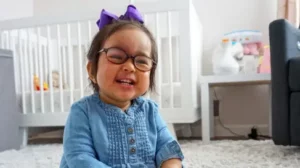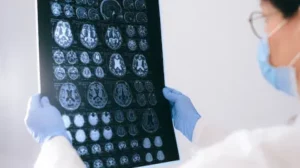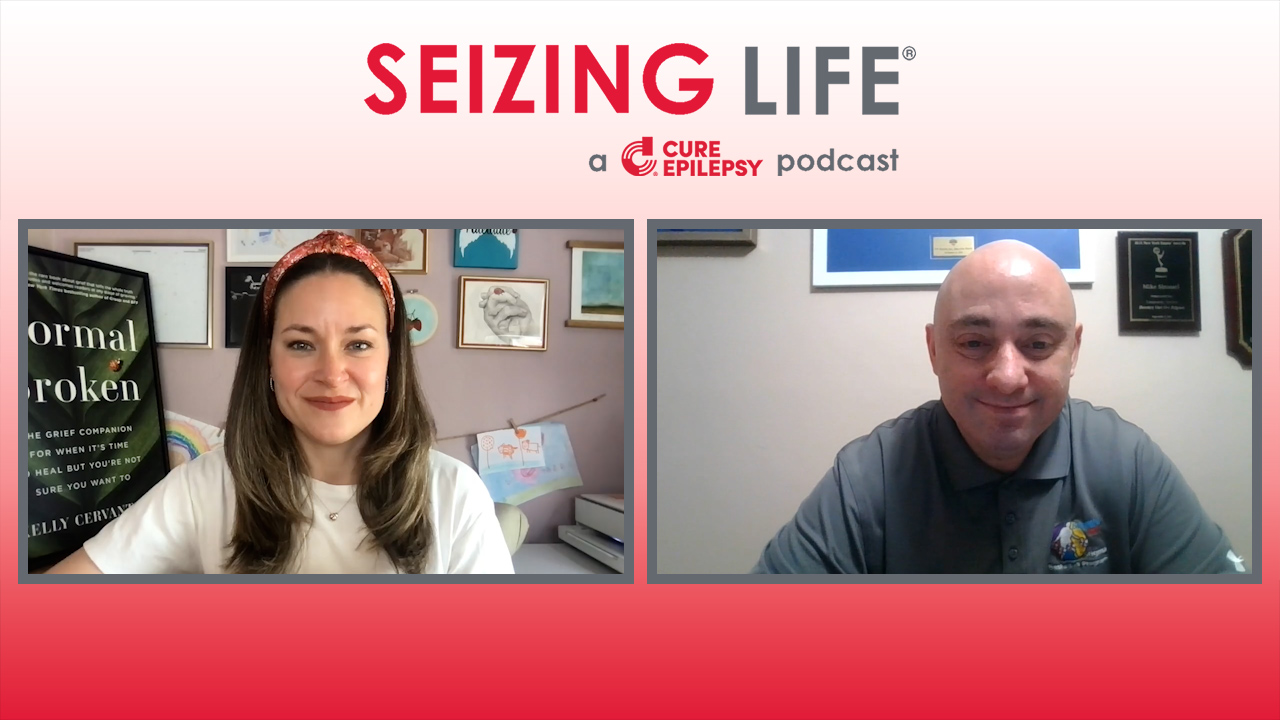Using Basketball to Fight Stigma and Empower Kids Living with Epilepsy
Episode Overview
This month on Seizing Life® Mike Simmel shares his epilepsy journey, explains how his passion for basketball helped him navigate the impacts of epilepsy, and recounts how a personal experience with epilepsy stigma inspired him to help kids living with epilepsy and other challenges.
Mike Simmel experienced his first seizure at the age of two and spent the early part of his childhood trying to get control of his epilepsy while living with the impacts of seizures and medications. His life changed when his father gave him a basketball and Mike discovered an overwhelming passion for the sport. A basketball became Mike’s constant companion, and the skills that he developed through practicing and playing the game not only helped him to overcome his early physical limitations but also led Mike to college basketball, then 15 years playing with the Harlem Wizards, and finally to what would become his life’s work. Mike recounts his early years of epilepsy, his period of seizure freedom, and the return of his seizures while attending a basketball camp at the age of 16. Mike explains how that particular incident made a deep impression on him that led him to found the Bounce Out the Stigma program years later in order to empower kids living with epilepsy, autism, and other challenges
Episode Transcript
Kelly Cervantes:
Hi, I’m Kelly Cervantes and this is Seizing Life, a monthly podcast produced by CURE Epilepsy.
Today, I’m happy to welcome Mike Simmel to the podcast. Mike has lived with epilepsy for most of his life. From an early age, Mike found that his passion for basketball helped him overcome some of the challenges of growing up with epilepsy. Mike has spent much of his life playing basketball and sharing his love of the sport through his Bounce Out the Stigma program, which aims to build self-confidence in kids with special challenges like epilepsy and autism. Mike is here today to share his epilepsy journey, discuss how basketball helped him in that journey, and explain how he uses it to help kids overcome challenges of their own.
Mike, thank you so much for joining us today. To kick things off, why don’t you talk to us about how epilepsy first entered your life and the circumstances surrounding your first seizure?
Mike Simmel:
Hi, Kelly. It’s a pleasure to be here. Thank you for having me. When I first started having seizures, I was age two. My first seizure, my family at the time lived in California and I was eating an English muffin at the table with my mom and my aunt. I was eating at the table in the kitchen and I fell to the ground and started shaking and my mom and my aunt thought at the time that I was just choking and they didn’t know what to do.
They called the EMT, they called the ambulance, and the EMT came to the house and they looked at me and they looked in my eyes, they saw my pupils were dilated. Immediately they called it and they said, “I think your son had a seizure.” They said to my mom, they took me to the hospital. They did some tests. Right then and there they called it on the fact that they probably thought it may have been epilepsy.
Kelly Cervantes:
Which is astonishingly quick to get an epilepsy diagnosis, which is incredibly fortunate. Some people have to wait such a long time. Do you have any idea what your parents were told initially about the epilepsy diagnosis?
Mike Simmel:
Yeah, for the first time it was mainly my mom and my aunt in the hospital initially in California. They did some tests. They ran through some different things at the hospital. It was so long ago, it was like 45 years ago. I’m getting so old now with all this hair, but it was a long time ago. It was just going through those tests and going through all the different things. After going through the tests, basically they saw what it was.
Then my dad came into the picture and they went to the children’s hospital in Los Angeles. Then they met with another doctor and went through more tests. Going through all that, they called it spade a spade and they said they know it was epilepsy. Then they did their due diligence. They did what they had to do. No, it was the BG era too. It was before Google.
Kelly Cervantes:
Has a cause for your epilepsy ever been determined?
Mike Simmel:
No, not really. Just like anything else with most people, you don’t know where it comes from.
Kelly Cervantes:
Absolutely. Do you know which medications you were prescribed initially and whether they worked?
Mike Simmel:
Initially, I was given phenobarbital and my mom said talking with her about it, she said that initially when I was given phenobarbital, it made me very, very sluggish, almost like a zombie. Then they gave me Dilantin and another medication, and that made me better where I was more mobile but a little bit less sluggish and more motor skills kind of slow and just came to two through seven I had to drop seizures. It was just something that I dealt with. Yeah, it was just very, very rough for me.
Kelly Cervantes:
I think it’s hard for people to understand. I certainly didn’t know when we started this journey with our family, I thought you just give the patient a medication and you give them a pill and they’ll be fine. Not realizing that sometimes the medications are more detrimental than the actual seizures are and that there’s no guarantee that those pills will even control the seizures.
It sounds like that was the case. Both situations were the case for you. Talk to us about what you remember ages two to seven, how that affected you socially, physically, cognitively?
Mike Simmel:
Absolutely. Between ages two to seven, I was slow. I wore a helmet at times. I remember having drop seizures and just falling on the ground and having many, many, many times a day just walking around with my parents and boom, just falling to the ground. I’d be eating my meals at the table and boom, hit my head. My parents would do things like create opportunities for me so that I wouldn’t have to hit my head on the table anymore.
They would put blankets on the floor and I’d eat my meals on the floor with plastic utensils and they would sit down on the floor with me so I wouldn’t feel alone. I had a very supportive support system and it was great to see that they would be there with me. Of course, I get chocolate ice cream for dessert. I’m just joking with that. It was great to see that they were very, very supportive with me.
Basically two through seven, I was very, I couldn’t hop on one leg. I couldn’t skip. My first year in school, I was in special education gym class, which is a very unbelievable thing to think about considering how far I’ve come. Now I could dribble four basketballs and to think of one time in my life I couldn’t even skip on one leg. I couldn’t hop on one leg, I couldn’t do a jumping jack.
When I was about six or seven years old, I couldn’t even do that. It’s just amazing. I needed help at times going to the restroom. It was really, really tough for me growing up and it’s just one of those things you deal with. My family was there for me every very step of the way. I guess the most important thing when you have epilepsy is to have that support network that are with you and make sure that they’re with you every step of the way.
Working through the medications and different things you have to deal with. The different doctors and the different prognosis that they give you and all the different things that you work through. It’s the most important thing to have like I said, have a great support network with you and I was so blessed to have that.
Kelly Cervantes:
Absolutely. I couldn’t agree with you more. I love that you had family picnics on the floor. That’s so heartwarming to hear this way to still be included and keep you safe in that way. It’s scary, ages two through seven, there’s so much brain development that is happening during that time. Then around age seven, your seizures just stopped. Tell us about that.
Mike Simmel:
Basically, when I was in New Jersey, then we moved back to New Jersey when I was about three years old. My family is originally from New Jersey. My mom and dad grew up in Hoboken, went to Hoboken High School.
Kelly Cervantes:
I hear Jersey in your voice.
Mike Simmel:
A little bit, a bit of an accent, some words. They moved back to New Jersey when I was about three years old. I have an older brother and my aunt stayed in California. She finished her schooling and my brother came back. We all came back together. We came back here. I saw another doctor from my epilepsy who was in Hackensack, New Jersey who put me, when I was seven years old, he said to my family, “You know what? Mike, he’s not really, I wasn’t seizing at the time, and I overcame my epilepsy through some medications that he gave me through some of the things that was going on with my body.
I outgrew my epilepsy at the time and things weren’t really happening and it took shape at that long time, the medications he gave. He said, “You know what, you never know what could happen down the road because 75% of the time people with drop seizures,” that’s what he told my mom. I said, “75% of the time people with drop seizures will experience seizures down the road. You never know what may happen, so be careful.”
I was just happy I didn’t have to go do EEGs anymore. I had to do any more blood work. I hate blood work more than anything else in the world. I hate the sight of blood. Fires and blood are my two bugaboos and also coconut and ice cream bars. Coconut and chocolate bars, those are my three major bugaboos, coconut and chocolate bars, fire and blood are my three bugaboos.
Seriously, kidding aside, I was so happy that I didn’t have to see the doctor anymore. I still was slow and that’s when basketball entered my life.
Kelly Cervantes:
Talk to us about that. How basketball entered your life because it has become such an enormous part of your life, which I can’t wait to talk about later.
Mike Simmel:
Absolutely.
Kelly Cervantes:
Right now, how did you discover this love for basketball?
Mike Simmel:
That was really, really cool. My dad gave me a basketball and I had slow motor skills so I couldn’t skip, I couldn’t hop. He gave me a basketball and I developed a game of basketball. I used to dribble the ball everywhere I went, I used to dribble as I walk my dog. I’m the only dog in the neighborhood that’s head would bounce up and down like this. My dogs had to do that, it was stupid.
I would dribble in my house. My mom didn’t like that too much. Dribble in school, the teacher took the ball away from me. She really did. My mom had to come to school and get the ball for me from the teacher. I had to do so much to play this game of basketball because I loved it so much. I would play it all hours of the day. In the summertime I would play, 90-degree heat, I would play.
As I got older, I played with old men when I was the youngest kid in the park just to get my skills up. The game just developed so much for me. It led to such good things. I dribbled everywhere I went. The motor skills in the game, it all came together for me just because my dad saw that the motor skills with basketball would coincide with the motor skills that I would need to overlap with the things that I would need to help with my epilepsy. I guess, my dad saw it as… I don’t know if he saw it like that, but it worked out like that. It was pretty neat to see.
Kelly Cervantes:
It’s fascinating too. I mean it’s like a physical therapy or an occupational therapy targeted through the game of basketball. It’s really brilliant of your dad to see that and encourage it in you.
Brandon:
Hi. This is Brandon from CURE Epilepsy. Have you or a loved one been recently diagnosed with epilepsy? Are you looking for more information about epilepsy and available treatment options? Go to cureepilepsy.org/for-patients to get resources and information about epilepsy. Now back to Seizing Life.
Kelly Cervantes:
Unfortunately, I know that the seizures did return around the time you were 16. Your mom had been warned about this, but no warning prepares you for the return, especially after almost 10 years that you had been seizure-free. What did that return look like?
Mike Simmel:
I’d been playing basketball and I played for, in high school. I played in club teams and I was a very good player. I could handle the ball really well. I went to a basketball camp at age 16. I was one of the best better point guards at the camp for my position. I was one of the younger point guards in the top levels of the camp and I was 16 years old. I was having a really, really good week. Everything was fine. Everything was going smooth.
I went to take a shower in the morning, in the middle of the week on a Wednesday. I remember it like it was yesterday. It was Wednesday morning and then next thing I knew, I opened my eyes and I looked up and the EMT were right there. They said, “Mike, you had a seizure and we have to take you to the hospital.” I was in the hospital and went back. Then my dad came to the hospital. He saw me because I was two hours away from my house. It was in Trenton, New Jersey.
Got me back to the dorm. I was okay, saw that I was okay, and then he went back home. He got a call from the camp and the director called my dad and he said, “Listen, Mr. Simmel, you got to come get Mikey because he can’t be at camp anymore because he has seizures. We can’t have him here anymore.” My dad was like, “Look, as a parent, you understand we’re going to know from our doctor, we’re going to know from our lawyer. Just clear him. We will bear the brunt of the responsibility.”
Camp said, “No, we can’t have him here. He has epilepsy and we don’t want to bear that brunt. You have to take him home.” My dad was a little upset. Long story short, he basically said to the camp, “Look, you’re going to keep him at that camp or we’re going to bring the news channel down there and we’re going to get our lawyer to sue you. It’s on your rear end.” He didn’t say rear end and he hung up the phone.
20 minutes later he got a call back, “All right, he can stay.” Basically, I stayed at that camp and always kept in the back of my mind if I was in a position to help kids down the road, I was going to do it based on that thing that happened at that camp that day. I felt so isolated and I felt so different. I just felt terrible. I hear the jeers and stuff, but it always kept me that I always wanted to help kids because I felt so lonely at that time.
Kelly Cervantes:
I’m so sorry that that happened to you.
Mike Simmel:
Well, no, it was just sad that somebody would think that way and that stigma that people make you label you because you’re different. I felt bad for my parents too, that they had to go through it, but it worked out fine.
Kelly Cervantes:
Stigma is real. It sounds like you have had pretty phenomenal parent advocates which would serve you well because the seizures didn’t end after that first one when you were 16. Now you’re in high school, you’re playing competitive basketball. How did the return of seizures affect you from that point forward?
Mike Simmel:
From high school and college, I was having [inaudible 00:14:51] I was having just many shakings. When I get the little shake tremors, I’d get those in the morning. When I woke up, I would get grand mal seizures. I had anywhere from two to three grand mal seizures a year, major seizures, all those stuff would happen in the morning just because of just stress or sleep. I don’t know if it was bad sleep or just stress. I was a very high-strung kid.
I would always get stressed while over tests in school. I would stressed over situations at the court. I’m very high-strung as an individual. You probably tell by me, I’m a very passionate young man and I was always stressful over situations and it would cause seizures. It’s okay to be vulnerable, but I’ve learned that in my life and it’s okay to let go.
Kelly Cervantes:
Did you tell your classmates or your teammates that you had epilepsy?
Mike Simmel:
I didn’t tell anybody at the time, and that’s one thing that I didn’t do and I regret not doing. The thing was I was having seizures and people found out that I had seizures because what would happen is I went to a high school and I went to a college. When I went to prep school and I went to college, I was having seizures at the school. People would find out because there’d be an emergency vehicle at the school.
The vehicle would come there, they pick me up and now everybody would find out. Now, everybody would know. The cool thing was my friends that were cool with me, they were still cool with me. The ones that weren’t, well they weren’t. The people that were really my good friends stayed my good friends and they were okay with it. I made a bigger deal of it than they did. Like I said, it’s okay to be vulnerable.
Kelly Cervantes:
Absolutely, I think it’s important to be vulnerable. You go to college and you play basketball in college. Talk about lack of sleep and stressful situations everything just amps up. I think we see a lot of kids who may have mild control of their epilepsy. It just all spirals out of control when they get to college and it can be scary. What did that look like for you? Did you tell anyone in college? Your coaches? Did you ask for any special accommodations?
Mike Simmel:
Yeah, I talked to my coaches about it. He was able to get me great preferred housing on campus where I got a nice dorm, a nice suite where I was living, nice living quarters where it was quiet where I could get sleep and stuff. I still had seizures. I mean, it didn’t go away. A couple of my teammates took care of me and stuff as far as if I had a seizure, they were there. Most of them knew.
As far as letting people know, people knew about it and the coach knew about it and stuff. He was fine with it. The amazing thing that happened in college that changed my life was I went and I saw a specialist at Columbia who became my doctor and he put me on a new medication which was extended release tablets, Depakote ER and Zonegran. That changed my life forever because it was taking it one time a day.
As you know in college, you lead a very busy life and having to take medication three or four times a day, it’s very hard to do, especially when you’re an athlete. You got to worry about lifting or you’re doing your homework or whatever you do, cardiovascular, all that stuff. Then going to class a couple of times a day, then going to practice, then getting your meals in and you need to write and getting the right sleep.
It’s very hard to have to worry also about not getting all your medications in too. It was very hard to get all that balanced, so that was hard for me. When my doctor put me on the extended release, there was times when I was seizure free for an extended period of time and I had that one breakthrough seizure and then it extended time I wasn’t, and then I had that one breakthrough. Then we mess around with it. Then now, I’ve been seizure-free for 15 years now. It’s a good thing.
Kelly Cervantes:
Incredible, congratulations on that. That’s absolutely wonderful. You graduate from college and you have done and accomplished so much, Mike. It’s wonderful. You’ve been in New York Knicks Ball Boy, you played for the Harlem Wizards. You’ve lectured and performed at hundreds of basketball camps over the year.
What I want to focus on for this next little bit is Bounce Out the Stigma. This is the program that you founded with your dad. Tell us about it, what it is, who it’s for, and what your goals are for the project?
Mike Simmel:
All that other stuff with the Ball Boy, the Knicks and the Wizards and all that other stuff, it was all great and stuff. I performed at the Apollo Theater, which kicked off everything to get to the Wizards and everything. That was like my Forrest Gump moment doing all this stuff and get all these awards and everything. Bounce Out the Stigma is my dream come true. That’s what my mission, as you said, it’s really what my life has been all about.
Everything’s been my platform to get to this moment, to have this Bounce Out the Stigma for. It’s the promise I made to myself as a 16-year-old kid at that camp to say, “This is what I want to do with my life.” What it is, it’s a basketball program designed for children with unique issues. What it was is me and my dad went out to dinner one night in 2005 when I was playing with the Wizards.
I was doing a lot of pro bono work for the Epilepsy Foundation, the National Foundation in the local foundation here in New Jersey. I was just doing a lot of work for them. Me and my dad went off for dinner one night. We were like know it would be a cool idea. We said know it would be a cool idea if we put together a basketball program designed for children who are in the middle of the road.
There’s programs for kids in mainstream. You got the All Star programs, the camp like you went to as a kid and stuff. Then there’s those special needs programs that are like the label programs, but the kids that are in the middle of the road, the kids that have epilepsy, autism, ADHD, spectrum disorders, all that stuff, down syndrome even, those kids don’t have basketball camps. There’s nothing for those kids.
“How cool would it be,” my dad said, “If you were the guy that they looked to that they could relate to show there are no limits and that these kids can have something somewhere to go. We could build this thing.” I said, “Dad, I’ve always wanted to do this.” We did this over doing pasta talking about this and pasta’s getting all over my face. I’m throwing the pasta in the air.
It is crazy, but it worked. I said, “Dad, I want to take this national, I’ll do this.” My dad went, “Calm down. Just write down what you want to do with it. Show it to me when you get a chance and we’ll do this.” This was 20 years ago. I wrote it all down and I typed it up and that night I showed it to my dad the next day he said, “We can run with this.” That summer put together a camp about 18 kids that summer.
It went great. This is 2005 in Ho-Ho-Kus, New Jersey. It went great. Then the next summer we partnered with the Epilepsy Foundation of New Jersey. We had three camps and one in Essex, one in Passaic and one in Bergen County and then we grew it. Then 12 years ago I took it on full-time. After I retired from the Wizards, I took it on full-time, it as my full-time project. I didn’t want it to be a hobby anymore. I wanted to take it on full-time.
We were in two other states, we were in North Carolina. We had two camps in North Carolina, but one in Charlotte. We had one in Winston-Salem. I said, “I’m going to take this thing on full-time.” I took it on full-time and now we’ve been in over 25 states throughout the country. This summer alone, we have 15 camps in seven states.
We have after-school programs, weekend programs. Really what we do is we take kids with special needs and we show them that they can be special and we show the kids limits don’t define, you define your limits. That’s what it’s all about.
Kelly Cervantes:
I think that that is absolutely remarkable. Congratulations because it’s a huge feat and a ton of work. It was named the Junior NBA Program of the Year in 2019. I mean, it’s remarkable.
Mike Simmel:
We were named Junior NBA National Program of the Year. We work with the Sixers, the Magic, the Hornets, and we’re junior affiliate of the New York Knicks. I was named Junior Knicks Coach of the Year in last year, 2024. I was named the Kentucky Colonel. I was named 10 Outstanding Young Americans, TOYA Award, which is a very famous award.
The TOYA award, which many famous people got. I don’t know, I still don’t understand how I got it. We were given citations by the City of Philadelphia and the State of New Jersey, Governor’s Award, all these different awards. Let me tell you something, all this great stuff that happens to us that makes it look like I’m like a Forrest Gump type of character.
It’s all great and everything, but the coolest stuff that happens to me is getting a hug from a kid that just came into the program and said, “You changed my life because know we changed our life.” Getting a high five from a kid or have the parents shake our hands saying, “You changed my child’s life because they had no idea how to play basketball when the first came into the program. Now they’re dribbling with two basketballs. They’re dribbling with one basketball for the first time in their life.”
Making a difference in a child’s life because when you could do that, that’s like changing the world for somebody. That’s a mission that God has given in your hands.
Kelly Cervantes:
Yes, the confidence that you are instilling in them in the world. It’s empowering, yes, absolutely. If someone wants to learn more about Bounce Out the Stigma camps and programs, where can they get that information?
Mike Simmel:
You can go to Bounceouttostigma.org for further information. Also, we have an Instagram page Bounce Out the Stigma and also we’re on Facebook as well.
Kelly Cervantes:
Amazing. I understand that you have also written a couple of books based on your experiences. Tell us about those.
Mike Simmel:
I’ve written two books. First one I co-wrote with another author called Mighty Mike Bounces Back, that was written in 2012 and that was more of an epilepsy centered book. It’s semi-autobiographical children’s book. What I did with that book was I wanted to help people with epilepsy and show them that you’re not alone. What we did in the back of that book, we did some first aid.
We did how to help cope with seizures and some tools dealing with seizures and things of that nature. It was actually published through the American Psychological Association in Print Imaginations Press. Also, my newest book, which I’m really so excited about because I did it myself and it’s part of the new series that’s going to be coming out. Part of the Bounce Out the Stigma Buddies series. It’s called Never Give Up. It’s about all types of disabilities.
It’s about some buddies that get together. The protagonist is a quick-witted character named Xander Zimmons. His buddy Evan Thomas. Xander has epilepsy and Evan has autism and they meet up and they play basketball together. They’re both shy kids. Xander’s a little crazy, but Evan balances them out and they meet and they go to a Mighty Mike Clinic.
They have some wild adventures together and they meet other kids with disabilities. It’s just a fun book. There’s epilepsy first aid in there. There’s autism facts, there’s epilepsy facts. The foreword in that book is written by John Starks, who was a former NBA player for the New York Knicks All-star player who played for the Knicks in the ’90s. He’s just a great guy and a friend of our program and a friend of mine. He did a great job writing forward. I’m really, really blessed and thrilled to bring that book to the public.
Kelly Cervantes:
Amazing. Where can people find those books?
Mike Simmel:
You can find the Mighty Mike Bounces Back is on Amazon. The second one at Bounce Out the Stigma Never Give Up. Never Give Up is at your local bookstore, barnesandnoble.com, amazon.com. The publisher, warrenpublishing.com or Warren Publishing or local bookstores anywhere, really.
Kelly Cervantes:
Anywhere books are sold. I love it.
Mike Simmel:
Anywhere books are sold, that’s it. I’m new at this.
Kelly Cervantes:
What do you wish the public knew about epilepsy and those who are living with it?
Mike Simmel:
I think that there’s a couple of things. Epilepsy is one of the most underfunded disabilities. I think that it needs to be funded more and I think it needs to be drawn out more in the public. I think people don’t know enough about it. I go to schools a lot and I talk to kids. I do a lot of school assemblies with my program and not a lot of kids know enough about it.
They don’t know people who have it. They don’t know enough people what it’s about. I asked kids, I said. “There could be a room with 300 kids.” I said to the kids, “Who knows what epilepsy is?” They raise their hands and maybe 4 kids that are 300 raise their hand. I asked, “Okay, what do you know?” They said, “Well, it’s when lights are flashing.” That’s all they know. They don’t know what epilepsy is.
There’s got to be a better educational outlet for these kids to understand what epilepsy is. There’s got to be more talk about epilepsy. I wish that there was more ways to get the public to get know about epilepsy in the media. I wish there was more funding for that to happen. I wish the stigma was not just people thought that was just somebody just shaking. There’s more to it than just that.
I just wish there was more education about epilepsy. I wish there was more funding. I wish the stigma and the labels about people with epilepsy that they can’t do things that they can and that limits don’t define you, define your limits. I always tell the kids, “Epilepsy doesn’t define you. You define you.
Kelly Cervantes:
I couldn’t agree with you more. Mike, thank you so very much for sharing your story, sharing Bounce Out the Stigma with us. Keep doing the amazing work that you’re doing because goodness gracious, is it needed. Thank you so much.
Mike Simmel:
Thank you, Kelly.
Kelly Cervantes:
Thank you, Mike for sharing your epilepsy journey and for all that you do to help kids through the Bounce Out the Stigma program. As Mike’s journey makes clear attaining seizure freedom can be a long and difficult journey for those living with epilepsy and their families. Unfortunately, one in three people diagnosed with epilepsy are unable to control their seizures with current medications. That is why CURE Epilepsy was founded in 1998.
Our mission is to fund breakthrough epilepsy research that will transform the lives of people with epilepsy as we lead the search for a cure. If you would like to support us in our mission, please visit cureepilepsy.org/donate. Thank you.
Legal Disclaimer:
The opinions expressed in this podcast do not necessarily reflect the views of CURE Epilepsy. The information contained herein is provided for general information only and does not offer medical advice or recommendations. Individuals should not rely on this information as a substitute for consultations with qualified healthcare professionals who are familiar with individual medical conditions and needs.
CURE Epilepsy strongly recommends that care and treatment decisions related to epilepsy and any other medical conditions be made in consultation with a patient’s physician or other qualified healthcare professionals who are familiar with the individual specific health situation.
